The Wheelchair Guide
Your Wheelchair and Mobility Scooter Resource
Electric Wheelchairs
Thursday, June 4th, 2009
The wheelchair is one of the oldest types of medical equipment known to man. Its uses can be traced back thousands of years and every year, the wheelchair greatly improves the lives of the mobility challenged. The electric wheelchair, on the other hand, is a much newer device and has only been available for about sixty years.
The first electric wheelchairs, which were developed during the nineteen-fifties, were simply manual wheelchairs that had been outfitted with an electric motor. They have changed a great deal since then, although there are a few that still share a similar design to these early electric wheelchairs. Most however, have a power base, which contains the electric motor, wheels, and batteries, with a chair mounted to the top of the base.
To control the wheelchair, a simple joystick is attached to the arm of the chair and the wheelchair user can simply push the joystick in the direction they wish to go. Most will also have a button for a horn, a battery meter, and a speed adjustment mounted in the armrest.
While for many people the joystick will provide an adequate control system, there are some who lack the ability to use this type of control and must instead use an alternate wheelchair control system. For instance, it is possible to control the wheelchair with head movements, breath, or even with a remote control. Currently, there are several companies working on a brain controlled wheelchair as well, which will eventually allow the wheelchair user to control their wheelchair with thoughts.
There are many different models of electric wheelchair available and a number of different manufacturers as well, but most electric wheelchairs can usually be classified as either rear wheel drive wheelchairs or mid-wheel drive wheelchairs.
A rear wheel drive wheelchair usually has 4 wheels and the two rear wheels are responsible for moving the wheelchair. They provide a very sturdy and stable base, because the weight is evenly distributed across the four wheels.
A mid-wheel drive wheelchair usually has 6 wheels. The set of wheels in the middle is used to move the wheelchair and the other wheels, which are located on the front and back of the base, are used to provide stability. A mid-wheel drive wheelchair is incredibly maneuverable, however the weight is not as evenly distributed, so it will not be as stable as a rear wheel drive wheelchair.
While the rear wheel and mid-wheel drive wheelchairs are the most common, there are also foldable electric wheelchairs, which use a frame that is similar to that of a manual wheelchair. These are popular for traveling, but lack many of the features of the other types of electric wheelchairs.
The electric wheelchair has greatly evolved over the last fifty years and today provides a very reliable and dependable way to allow a mobility challenged individual to get around.
What are Power Chairs?
Tuesday, June 2nd, 2009
The wheelchair is easily one of the most important medical devices of all time and its roots can be traced back thousands of years. Today, more and more people are using electric wheelchairs.
Electric wheelchairs were first developed in the nineteen-fifties when an electric motor was added to a manual wheelchair. They quickly became popular because a manual wheelchair requires a great deal of physical effort to use and a lot of upper body strength, making them impossible to use for many who are mobility challenged. An electric wheelchair, on the other hand, can be moved by only lifting a finger and there are a number of alternate wheelchair control systems available as well, such as a system that allows the wheelchair to be controlled by the breath of the user.
There are many manufacturers of electric wheelchairs, but two of the most well known are Golden Technologies and Pride Mobility. Both of these companies offer a wide assortment of home medical equipment, including a number of different electric wheelchairs. There are of course many other manufacturers, including ShopRider, so it is a good idea to explore all of your options when shopping for an electric wheelchair.
While there are many different models of electric wheelchairs available, they can typically be classified as either rear-wheel drive, mid-wheel drive, or travel wheelchairs.
Rear-wheel drive wheelchairs are propelled by their rear wheel and the weight of the user is evenly distributed across the electric wheelchairs base. Mid-wheel drive wheelchairs feature three rows of wheels, with the row in the middle being responsible for moving the wheelchair. A mid-wheel drive wheelchair is much more maneuverable than a Rear-wheel drive wheelchair, but the weight is not as evenly distributed, so it does not provide as stable of a platform. For most, the difference is negligible, but in some outdoor situations and for those who require a higher weight capacity, the rear-wheel drive wheelchair might be the best choice.
Travel wheelchairs come in several different designs, but are lighter and easier to transport than other electric wheelchairs. Some are designed so that they can be taken apart into easy to manage pieces and others share a design similar to a steel tubed manual wheelchair, allowing them to be folded up when not in use. They typically have a shorter range and fewer features, but can usually be transported without requiring a vehicle wheelchair lift, which would typically be required to transport non-travel wheelchairs.
For millions of people across the globe, the electric wheelchair allows for increased mobility and accessibility, allowing them to effortlessly move around.
Manual Wheelchairs for Seniors
Monday, May 18th, 2009
For a senior, walking for extended periods of time can often be very difficult, which is often the result of injuries or in some cases diseases, such as arthritis. Finding a way to increase accessibility and mobility is very important and often a manual wheelchair will offer the least expensive option for a senior.
A Brief Introduction to Manual Wheelchairs
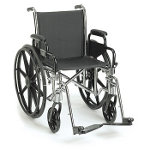 The wheelchair is probably the most well recognized and well known mobility aid, and its origins can be traced back many thousands of years. However, the modern wheelchair, with its steel tubed frame, two large wheels in back, and smaller wheels in front, is actually a fairly recent inventions. These manual wheelchairs, which can be found at virtually any hospital, store, or airport, are based off of the E & J wheelchair, which was first developed and refined during the 1920′s and 30′s.
The wheelchair is probably the most well recognized and well known mobility aid, and its origins can be traced back many thousands of years. However, the modern wheelchair, with its steel tubed frame, two large wheels in back, and smaller wheels in front, is actually a fairly recent inventions. These manual wheelchairs, which can be found at virtually any hospital, store, or airport, are based off of the E & J wheelchair, which was first developed and refined during the 1920′s and 30′s.
The E & J wheelchair, which features lightweight steel tubing and can be easily folded to make transportation easier, is still around today and serves as the basis for most manual wheelchairs. In fact, early electric wheelchairs also used the E & J design. Today there are many adaptations of the E & J wheelchair and many improvements have been made to increase durability, reduce weight, and improve comfort.
Seniors and Manual Wheelchairs
For a senior, a manual wheelchair is often one of the easiest ways to make getting from point a to point b easier. However, using a manual wheelchair requires a good deal of upper body strength, so as a result, most seniors who use manual wheelchairs rely on a family, friend, or caretaker member to push the wheelchair.
Due to their lightweight and lower cost, manual wheelchairs do make an excellent choice for traveling or going places, like an amusement park, where a lot of walking is required. This is of course, as long as there is someone available to operate the wheelchair.
In addition to the large rear wheels and smaller front wheels, manual wheelchairs also include anti-tip casters. Ant-tip casters extend from the rear of the wheelchair, usually at least six inches from the ground. In the event that the wheelchair is tipped backwards, the anti-tip casters make contact with the ground, keeping the wheelchair from completely tipping over.
Seniors and Transport Chairs
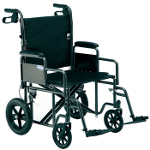 If the senior is not going to be using the wheelchair at all, transport wheelchair, which are also called transfer chairs, are available as well. A transfer chair is similar to a wheelchair, however it does not feature the large rear wheels, which make it possible for the wheelchair user to roll the chair independently, but are instead designed to make it easier for a caretaker or family member to roll the wheelchair. These are often a good choice because they are typically lighter and smaller, making them easier for a caretaker to use.
If the senior is not going to be using the wheelchair at all, transport wheelchair, which are also called transfer chairs, are available as well. A transfer chair is similar to a wheelchair, however it does not feature the large rear wheels, which make it possible for the wheelchair user to roll the chair independently, but are instead designed to make it easier for a caretaker or family member to roll the wheelchair. These are often a good choice because they are typically lighter and smaller, making them easier for a caretaker to use.
Pros and Cons of Manual Wheelchairs for Seniors
While manual wheelchairs or transfer chairs are often the easiest type of mobility aid to procure and are also often the most cost effective option, for a senior, they are often not the easiest type of mobility aid for a senior to use.
For use around the home, it could be a good choice, as they are very maneuverable and in such a small area, it would not require too much effort to use the chair. For long distances though, using a manual wheelchair could quickly become tiring for a senior, so manual wheelchairs might not provide the best choice for a senior who lives independently.
Electric Power Wheelchairs: An Introduction
Wednesday, April 29th, 2009
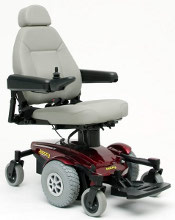 The electric wheelchair is today very popular and has been around since the early 1950′s. Early electric wheelchairs simply used the frame of a manual wheelchair and added an electric motor to it. Unlike manual wheelchairs, which require a great deal of upper body strength to use, electric wheelchairs require virtually no effort on the part of the user. They are also often referred to as power chairs or electric power chairs.
The electric wheelchair is today very popular and has been around since the early 1950′s. Early electric wheelchairs simply used the frame of a manual wheelchair and added an electric motor to it. Unlike manual wheelchairs, which require a great deal of upper body strength to use, electric wheelchairs require virtually no effort on the part of the user. They are also often referred to as power chairs or electric power chairs.
Today, some models are still available that use a traditional manual wheelchair design, but most make use of a molded plastic base, which contains the electric motor. One or more batteries is also contained in the base of the electric wheelchair, which allows it to be used over great distances.
The range and top speed of an electric wheelchair varies by model, but most are able to at least travel 5 miles on a single charge and at speeds of around 4 mph. The weight capacity of electric wheelchairs varies by model, but 250 pounds is almost an industry standard.
The chair of the electric wheelchair in some regards resembles an office chair, with a high back and armrests on either side. It includes a good deal of padding and can be reclined. It also usually swivels to the left or right, allowing for the power chair to be exited in a safe manner. The chair, which is often called the Captain’s Chair, usually has foldable armrests to further facilitate smooth transfers into and out of the chair. Some even have an electrical lifting system, which raises and lowers the chair. This can be important if, for example, using a table that is higher than normal.
Electric Wheelchair Control Systems
Most power chairs use a joystick control that is mounted to the armrest of the chair. This design is the same used on the first electric wheelchairs and can be configured for use on the left or right side of the power chair. There are also a number of alternate controls available for those who are not able to operate the joystick.
Perhaps the most common alternate wheelchair control allows the wheelchair to be controlled by the users breath. Blowing into the wheelchair moves it forward and breathing in moves it backwards. The direction of the wheelchair can also be controlled. There are a number of other alternate controls, including a remote control that can be operated by a caretaker.
Portable Power Chairs
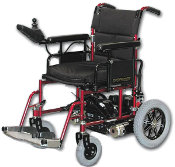 If you want to transport a traditional power chair, it is usually necessary to use a wheelchair lift. However, portable power chairs are available, which are lightweight and can be folded to take up less space. These models closely resemble a manual wheelchair, with a steel or aluminum frame and cloth seat. However, they still weigh a great deal more than a manual wheelchair would.
If you want to transport a traditional power chair, it is usually necessary to use a wheelchair lift. However, portable power chairs are available, which are lightweight and can be folded to take up less space. These models closely resemble a manual wheelchair, with a steel or aluminum frame and cloth seat. However, they still weigh a great deal more than a manual wheelchair would.
The motor and battery is installed under the seat and while these units often do not have as far of a range as other power chairs, they are easier to transport.
Manual Wheelchair Parts Diagram
Monday, April 20th, 2009
Today, there are a number of different wheelchairs available, but the most common is the steel framed wheelchair. This type of manual wheelchair shares the E & J design, which was developed over eighty years ago, and is the type found in most hospitals. They are also referred to as Traditional wheelchairs, standard wheelchairs, or Conventional Wheelchairs.
Below, you will find a diagram of a traditional wheelchair and a list of its components. Click on any of the links to find out its description or you can scroll down the page.
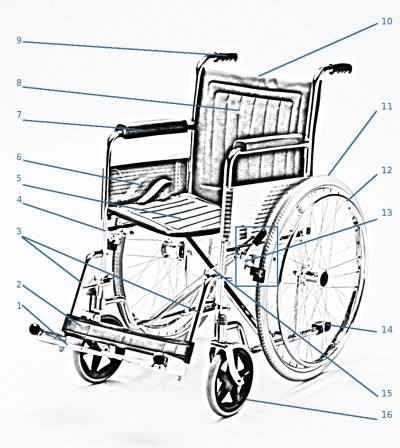
- Footrest
- Legrest
- Front Rigging
- Frame
- Seat
- Metal Skirt
- Armrests
- Backrest
- Push Handles
- Push Axle
- Rear Wheels
- Handrims
- Brakes
- Tipping Lever
- Crossbars
- Caster Wheels
- Anti-Tip Casters (Not Pictured)
1. Footrest: The footrests, which are also called footplates and footpedals, can be adjusted to accommodate different lengths and can also be rotated.
2. Legrest: The legrest extends from the front of the wheelchair and the footrest is attached to the legrest.
3. Front Rigging: The front rigging refers to the footrest arm and the legrest as a single unit. In most conventional wheelchairs, the front rigging can be removed, but this is not always the case in less expensive models. It can also often be elevated to provide an elevated leg rest.
4. Frame: The conventional wheelchairs frame is made out of cold rolled steel that is chrome plated. The frame is the heaviest part of the wheelchair and it can weigh up to 50 pounds, but a stainless steel frame is also available that weighs about ten pounds less.
5. Seat: The seat, like the other fabric parts of a conventional wheelchair, is made from vinyl and uses a sling design. Multiple colors are often available and the vinyl fabric makes it very easy to clean.
6. Metal Skirt: The metal skirt is installed on either side of a conventional wheelchair between the armrests. It is designed to protect the users clothes from dirt, moisture, and debris that can be kicked up by the wheels. Metal Skirts also prevent the users clothes from becoming caught in the wheelchair.
7. Armrests: There are two types of armrests: Full length and Desk Type. The armrests are secured to the frame in two places and are designed to be very sturdy.
8. Backrest: The Backrest height is fixed and typically is about 16 ½ inches high. However, reclining backrests and extending backrest are available as options for most conventional wheelchairs.
9. Push handles: The Push Handles are located on the back of the wheelchair and rubber handles are installed to make them more comfortable.
10. Push Axle: The Push Axle ensures provides support for the push handles and is at a fixed height.
11. Rear Wheels: Typically the rear wheels will be 24 inches in diameter. Both Pneumatic and Solid tires are used. The rear wheels are used for manual propulsion of the wheelchair.
12. Handrims: The handrims extend outwards from the rear wheel. They are typically chrome plated and are used to propel the wheelchair.
13. Brakes: The brakes are located on the large rear wheels. They are typically located on the front of the wheel next to the bottom of the seat.
14. Tipping Lever: The tipping lever extends from the bottom of the frame and is designed to make it easier to move the wheelchair over obstacles, such as curbs. The person pushing the wheelchair will put weight on the tipping lever, which causes the wheelchair to tip backwards.
15. Crossbars: The crossbars are located under the seat and allow the wheelchair to be easily folded for storage and transportation. There are typically no locks to keep the conventional wheelchair from folding, but instead the weight of the user prevents the wheelchair from being folded.
16. Caster Wheels: The wheels of a conventional wheelchair are called caster wheels and are typically 8 inches in diameter. They are typically made of solid rubber, but for outdoor use pneumatic tires are recommended.
17. Anti-Tip Casters (Not Pictured): Anti-Tip Casters are not always present on conventional wheelchairs, but they can usually be added. They are designed to prevent the wheelchair from tipping over backwards. In the event that the wheelchair tips over too far, the anti-tip casters make contact with the ground, preventing it from completely tipping over.
The conventional wheelchair remains one of the most popular and recognized type of manual wheelchairs available. They are often available in a number of different colors and many offer features to make them easier to use, such as removable armrests to make transferring into and out of the wheelchair easier. They can be seen in public areas, like hotels, airports, grocery stores, and hospitals, which offer wheelchairs for their patrons to use.
Challenges Faced by New Wheelchair Users
Thursday, April 16th, 2009
 Today, there are a number of different types of wheelchairs available. There are literally hundreds of different features and designs that are available to help fit the needs of wheelchair users. For the new wheelchair user, choosing the right wheelchair can often be a very difficult and confusing task.
Today, there are a number of different types of wheelchairs available. There are literally hundreds of different features and designs that are available to help fit the needs of wheelchair users. For the new wheelchair user, choosing the right wheelchair can often be a very difficult and confusing task.
Usually when an individual gets their first wheelchair, they do not know a lot about how wheelchairs work and what features will fit their needs. Often, a doctor will prescribe a wheelchair as part of their treatment and then take measurements of the individual to determine what type of wheelchair to order. There are actually a number of problems that can arise from this process, but they typically are caused by the patients own lack of knowledge of wheelchairs and the fact that the doctor is not a wheelchair user.
Since many doctors have never actually used a wheelchair for an extended period of time, through no fault of their own, they might not be the best resource for fitting an individual to a wheelchair. The patient, who is also inexperienced in wheelchairs, turns to the doctor as an expert on wheelchairs, but this is not going to always be the case.
Instead, the doctors experience with wheelchairs is often limited to a few days of training during college, so they measure the patient and plug the numbers into a worksheet to determine the proper dimensions. As a result, the wheelchair prescribed might not fit the best needs of the patient.
This is, of course, not to say that all doctors are poorly, have an ill intentions, or are not a good source of information. However, it is important to understand that since the doctor or specialists has probably never used a wheelchair for an extended period of time, they are not always as knowledgeable about the subject as a person might think.
To help deal with these challenges, there are a number of things the wheelchair user can do. First and foremost, it is a good idea to do some research about wheelchairs. This can involve reading articles about wheelchairs, but it is highly recommended to also talk with someone else who uses a wheelchair, because they offer a wealth of information.
Another great source of information is actually wheelchair salesman. They quite often know a great deal about wheelchairs and can be a great resource. However, since they are a salesman, it is imperative to remember they want to sell you a wheelchair and so, might not provide you a completely objective view. Instead, they will likely only mention products they offer, so it is very important to take what they say with a grain of salt.
One of the major parts of determining what type of wheelchair is best, will revolve around where the wheelchair will be used and the physical abilities of the rider. Since manual wheelchairs can be very strenuous, someone with very limited mobility might not be able to successfully use it, the physical abilities of the wheelchair user will be one of the most important considerations.
There are also a number of features and adjustments that can be made to the wheelchair to make it more comfortable and usable. For instance, some manual wheelchairs do not have armrests, which can make it more maneuverable, less strenuous on the arms, and easier to move under a table. Others have lowered backs, which make turning around in the wheelchair easier, or are designed to move much faster than traditional wheelchairs. This can be one area where an existing wheelchair user can offer excellent insight, but remember that some of these factors will come down to personal preference.
Understanding the options available and doing a good bit of research, can make finding the right wheelchair much easier.
For the wheelchair user, being involved in the wheelchair selection is imperative and one of the most important things they can do, because when a wheelchair is prescribed strictly by the books and without input from the patient, it will not always fully meet their needs.
The Beginning of the Modern Manual Wheelchair
Saturday, April 4th, 2009
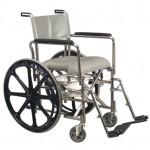 For most, the image of the manual wheelchair is very well known and the first thought when the word wheelchair is mentioned. They are also the oldest type of wheelchair, with records of manual wheelchairs dating back many thousands of years. Of course, these early wheelchairs looked a great deal different from the manual wheelchair of today.
For most, the image of the manual wheelchair is very well known and the first thought when the word wheelchair is mentioned. They are also the oldest type of wheelchair, with records of manual wheelchairs dating back many thousands of years. Of course, these early wheelchairs looked a great deal different from the manual wheelchair of today.
Some of the earliest records of wheelchairs date back to the early Asian empires and are known about only because of the images found by historians. These devices were often simply just wheeled carts and were even sometimes pulled by animals. As time progressed, the wheelchair would continue to develop, but there was not a real standard until the late 1800′s. Up until this point, wheelchairs came in many different sizes and often very cost prohibitive. In most cases, these early wheelchairs were only available to nobility, who had them custom built.
By the beginning of the 1900′s, a wicker wheelchair had become popular, but it was rather heavy to use and could not be self propelled. This changed with the development of the E & J wheelchair. The E & J wheelchair used hollow steel tubing to provide a strong, but lightweight frame. It could also be folded to take up less space and featured large wheels in the back. The wheels were designed so that the wheelchair user could propel themselves without assistance. Since the wheelchair could be folded and was so lightweight, it could be easily traveled with, making it very popular.
Around the same time that the E & J wheelchair was developed, World War II began. During the previous war, World War I, there had been a number of wounded soldiers, but due to the medical conditions, there was not that high of a survival rate. However, by the time World War II had began, there had been a number of improvements in medical care. One of the most important being the discovery of penicillin, which is a powerful antibiotic. As a result, there was large increase soldiers who survived as paraplegics. This increase would drive demand for the E & J wheelchair.
This early wheelchair would form the basis for the modern wheelchair and its basic design is still used today.. Its design being used in almost all forms of manual wheelchairs.
Wheelchair Basketball
Monday, November 10th, 2008
Wheelchairs have been used pretty much since the beginning of time, but until the 1900′s, they really didn’t resemble the wheelchairs of today. By the 1930′s, there were several steel tubed wheelchairs available that closely resemble the type of chair you see today. It was also around this time that wheelchairs sports first became popular.
The late 1930′s until the mid 1940′s, were a very violent time. Many millions of people lost their lives during World War II, but there were also a lot of medical advances, such as the use of penicillin to fight infection. Due to these advances, there was an increased number of soldiers who survived serious injuries, but were left disabled. It was this influx of disabled veterans that would lead to the development of wheelchair sports.
One of the first wheelchair sports to be played was wheelchair basketball. The first recorded game between veterans took place in 1946, but it is usually attributed, at least in part, to a German neurologist named Ludwig Guttmann. Guttmann fled Germany during the beginning of the Second World War. After the war, he founded the National Spinal Injuries Centre, which was located near London in Stoke Mandeville Hospital. He firmly believed that sports were an integral part of rehabilitation and would go on to found the Stoke Mandeville Wheelchair Games, which were the predecessor to the Paralympics.
After that first game of wheelchair basketball in 1946, the popularity would quickly spread among veterans and others who used wheelchairs. It became a part of the Stoke Mandeville Wheelchair Games in 1956 and the International Wheelchair Basketball Federation was founded in 1973. Today it is played by thousands in countries all over the World.
The Basics
Wheelchair basketball is played on a regulation basketball court and the rules are based off of the official NCAA rules, with some changes to address the needs of those in wheelchairs.
Generally in order to play, the individual must be affected by some sort of leg disability or paralysis that affects the lower part of their body, but there are some teams that have able bodied players on them. To achieve a balance, each player is ranked according to their abilities. The players are classified by their disability, for instance a player with complete motor loss would be classified as a Class I player. There is a set amount of points attached to each classification and the total point value of a teams active players can not be greater than 12. This is designed to create a team balance.
The wheelchair used to play wheelchair basketball must also meet several requirements. The height of the seat should not be greater than 21†and the foot rest should not be higher than 5â€. A seat cushion is permitted for each player, but it can not exceed 2†to 4†depending on the players classification. The wheelchairs are usually outfitted with anti-tip bars and other protective tools
General contact rules apply, such as charging and blocking, and the wheelchair is considered part of the players body. Players in possession of the ball may push their wheels to advance, but they can not push more than twice without either dribbling or passing the ball. Pushing more than twice is considered traveling.
A player will loose possession of the ball if they make any contact with the floor. This includes if the wheelchair tips back far enough that the anti-tip wheels make contact with the floor. Generally if a player falls from their chair, the referees will not stop the game unless there is a danger to the player.
Wheelchair Controls and BCI
Monday, November 10th, 2008
The first electric wheelchair was invented in the fifties. This chair made use of a simple control stick that could be mounted to either side of the chair. This allowed the chairs occupant to control the movement of the wheelchair using little more than a finger. This control setup is still very common, but, as the inventors in the fifties quickly realized, many people cannot use the joystick system.
Alternative control methods were developed almost as soon as the electric wheelchair was created. Several different control schemes were created, but the most common utilized head movement to control the wheelchairs.
There are many different control setups that are used today, including several that utilize head movements. One of the most common types of alternate wheelchair control uses the breath of the user to control the chair. The occupant will blow or suck through a small straw, which controls the wheelchair.
Several different wheelchair control systems are currently in the development stage, which use computers to control the chair. One uses voice recognition software to control the chair, while another uses a small magnet that is stuck to the riders tongue. A special headset picks up the movements of the magnet and sends them to a computer.
Recently, thought controlled computers have begun to be experimented with. This is commonly referred to as a brain-computer interface (BCI.) The development of a BCI actually began in the seventies, but it wasn’t until the middle of the nineties that an actual working prototype was built.
A brain-computer interface offers two different services. It can allow an individual to interact with a computer or it can be used to help trigger nerves and possible facilitate movement. In the terms of wheelchair control, the ability to interact with the computer is of most importance, but being able to have the computer signal back if there is an object in the way, could also be extremely beneficial.
In regards to wheelchairs, this technology offers many exciting applications. Computer controlled wheelchairs are currently available and being developed. These machines can be for the most part completely controlled by a laptop, so using BCI, an individual will eventually be able to control their wheelchair with only a thought.
There are two main types of Brain Controlled Interfaces: Invasive and non-invasive. Invasive BCI, involves physically implanting an electrode into the brain. These offer the clearest signal, but pose a health risk, as sometimes the area will scar or weaken. There are also a less invasive version that implants electrodes into the head, but not into the brain. This improves signal, but reduces the risk of irritating the brain.
Non-invasive BCIs are more common today. A user will wear a piece of headgear that is covered in electrodes. The signal is weaker, but it is currently safer to use in this manner.
Brain Controlled Computers will likely play a big part in rehabilitation treatment in the future. Several studies and commercial ventures are currently taking part in research and development of BCI. There are several systems available that allow a user to control a computer with their mind and thereby allowing them to speak and communicate their thoughts.
Electric Wheelchairs
Monday, November 10th, 2008
The first electric wheelchair was developed in the early 1950′s. These early power chairs took an existing wheelchair, usually the E & J manual wheelchair, and outfitted them with an electric motor. These chairs quickly became popular and today millions of people benefit from electric power wheelchairs.
While today, electric wheelchairs are much more advanced than the first electric power chairs, they do share one similarity. The joystick control system was first developed in the fifties and is still one of the most popular means of controlling an electric wheelchair today. The joystick can be mounted on either side of the chair and usually only requires a little bit of pressure for the occupant.
There are many people, however, who can not use this type of control system, so there are also several types of alternate control methods that can be used with an electric wheelchair that do not require the use of the occupants hands.
An electric wheelchair and a manual wheelchair share many similarities in regards to the services they provide, but they are also very different. Since power chairs are electric powered, it is necessary to charge them after each use. The range that a power chair can travel per charge depends largely on the model, but the places that you choose to use it can also effect the range. For example, driving the power chair up a very steep hill will cause the chair to loose its charge quicker. Most can travel a minimum of ten miles on a single charge.
An electric wheelchair will typically have a minimum of 4 wheels, but some have six. In these cases, the extra wheels are more for support. The way the wheelchair is propelled will help determine how many wheels it has. A traditional electric wheelchair usually only has four wheels and the rear wheels are what actually move the chair. These are called rear wheel drive power chairs.
A, relatively, new type of wheelchair has become very popular over the last ten years. These chairs use a mid-wheel drive system, a set of stability wheels located in front and in the back of the chair. The mid-wheel drive wheelchair is incredibly maneuverable and this makes it great for indoor usage.
Electric wheelchairs are incredibly popular today and many people would not be able to get around with them.